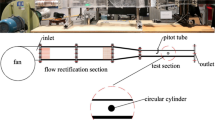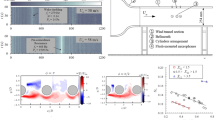Abstract
The objective of the present study is the detailed analysis of the unsteady vortex dynamics downstream of the human glottis during phonation at typical fundamental frequencies of the male voice of about 120 Hz. A hydraulic respiratory mock circuit has been built, including a factor of three up-scaled realistic dynamic model of the vocal folds. Time-resolving flow measurements were carried out downstream of the glottis by means of high-speed particle image velocimetry (PIV). The function of the human glottis is reproduced by two counter-rotating cams, each of which is covered with a stretched silicone membrane. The three-dimensional (3-D) geometry of the cams is designed such that the rotation leads to a realistic time-varying motion and profile of the glottis and waveform of the glottal cycle. Using high-speed PIV, the velocity field is captured with high spatial and temporal resolution to investigate the unsteady vortex dynamics of the cyclic jet-like flow in the vocal tract. The results help us to understand the vorticity interaction within the pulsating jet and, consequently, the generated sound in a human voice. In addition, changing the 3-D contours of the cams enables us to investigate basic pathological differences of the glottis function and the resulting alterations of the velocity and vorticity field in the vocal tract. The results are presented for typical physiological flow conditions in the human glottis. The frequencies of periodic vortex structures generated downstream of the glottis are fivefold higher than the fundamental frequency of the vocal folds’ oscillation. The highest vorticity fluctuations have a phase shift of 35% relative to the opening of the glottis. Finally, the flow field in the vocal tract is identified to be highly three-dimensional.















Similar content being viewed by others
References
Agarwal M, Scherer R, Hollien H (2003) The false vocal folds: shape and size in frontal view during phonation based on laminagraphic tracings. J Voice 17(2):97–113
Agarwal M, Scherer R, De Witt K (2004) Effects of false vocal fold width on translaryngeal flow resistance. In: Proceedings of the International Conference on Voice Physiology and Biomechanics: Modeling Complexity, Marseille, France, August 2004
Alipour F, Ni J (1992) Numerical simulation of unsteady flow in the glottal constriction with moving boundaries. J Acoust Soc Am 92(4):2391
Alipour F, Titze I (1994) A Navier–Stokes solution of laryngeal flow during vocal fold oscillations. J Acoust Soc Am 96(5):3341–3342
Barney AM, Shadle CH, Davies POAL (1999) Fluid flow in a dynamic mechanical model of the vocal folds and tract. I. Measurements and theory. J Acoust Soc Am 105(1):444–455
Brücker Ch. (1997) High-speed video: an upcoming chance for time-resolved 3-D velocimetry based on light-sheet tomography. In: Ruck B, Leder A, Dopheide D (eds) Proceedings of the Seventh International Conference of Laser Anemometry, Advances and Applications, Karlsruhe, Germany, September 1997, GALA, pp 427–435
Brücker Ch. (1999) The 3-D evolution and bursting of the starting vortex downstream of a backward-facing step studied by sequential high-speed scanning PIV. In: Proceedings of the Eighth International Conference of Laser Anemometry, Rome, Italy, September 1999
Deverge M, Pelorson X, Vilain C, Lagrée P-Y, Chentouf F, Willems J, Hirschberg A (2003) Influence of collision on the flow through in-vitro rigid models of the vocal folds. J Acoust Soc Am 114(6):3354–3362
Erath B, Plesniak M (2003) Development of the unsteady Coanda effect in human phonation. In: Oral Session in the Division of Fluid Dynamics 56th Annual Meeting, East Rutherford, New Jersey, November 2003
Fuks L (1998) Acoustical, physiological and perceptual aspects of reed wind instrument playing and vocal-ventricular fold phonation. PhD thesis in music acoustics KTH, Sweden
Hermes DJ (1991) Synthesis of breathy vowels: some research methods. Speech Commun 10:497–502
Hirano M, Yoshida T, Kurita S (1987) Anatomy and behavior of the vocal process. In: Baer T, Sasaki C, Harris K (eds) Laryngeal function in phonation and respiration. College Hill Press, Boston, Massachusetts, pp 1–13
Hirschberg A, Pelorson X, Hofmans G, Hassel R, Wijnands P (1996) Starting transient of the flow through an in-vitro model of the vocal folds. In: Davis PJ, Fletcher NH (eds) Vocal fold physiology: controlling complexity and chaos. Singular Publishing Group, San Diego, California, pp 31–46
Kaiser JF (1983) Some observations on vocal tract operation from a fluid flow point of view. In: Titze IR, Scherer RC (eds) Vocal fold physiology. Denver Center for Performing Arts, Denver, Colorado
Liljencrants J (1991) Numerical simulations of glottal flow. In: Proceedings of the 2nd Eurospeech conference (Eurospeech’91), Genoa, Italy, September 1991, vol 1, pp 255–258
Lippert WKR (1955) Wave transmission around bends of different angles in rectangular ducts. Acustica 5:274–278
Lopez I, van Hirtum A, Schellekens MH, Driessen NM, Hirschberg A, Pelorson X (2004) Buzzing lips and vocal folds: the effect of acoustical feedback. In: De Lanfre, Axisa (eds) Proceedings of the 8th International Conference on Flow Induced Vibration (FIV 2004), Paris, France July 2004
Mongeau L, Franchek N, Coker CH, Kubli RA (1997) Characteristics of a pulsating jet through a small modulated orifice with application to voice production. J Acoust Soc Am 102(2):1121–1133
Pelorson X, Hirschberg A, van Hassel RR, Wijnands APJ (1994) Theoretical and experimental study of quasisteady-flow separation within the glottis during phonation. Application to a modified two-mass model. J Acoust Soc Am 96(6):3416–3431
Ruck B (1990) Laserlichtschnittverfahren und digitale Videobildverarbeitung. In: Ruck B (ed) Lasermethoden in der Strömungsmeßtechnik, Berlin, Germany, September 1990, pp 367–409
Scherer RC, Shinwari D, De Witt KJ, Zhang C, Kucinschi BR, Afjeh AA (2002) Intraglottal pressure distributions for a symmetric and oblique glottis with a uniform duct. J Acoust Soc Am 112(4):1253–1256
Teager HM, Teager SM (1990) Evidence for non-linear sound production mechanisms in the vocal tract. In: Hardcastle WJ, Marchal A (eds) Speech Production and Speech Modelling. Kluwer, Dordrecht, The Netherlands
Titze I (1988) The physics of small-amplitude oscillation of the vocal folds. J Acoust Soc Am 83(4):1536–1552
Vilain CE, Pelorson X, Hirschberg A, Le Marrec L, Root WO (2003) Contribution to the physical modeling of the lips. Influence of the mechanical boundary conditions. Acta Acust United Ac 89(5):882–887
Zhang C, Zhao W, Frankel SH, Mongeau L (2002) Computational aeroacoustics of phonation, part II: effects of flow parameters and ventricular folds. J Acoust Soc Am 112(5):2147–2154
Zhao W, Zhang C, Frankel SH, Mongeau L (2002) Computational aeroacoustics of phonation, part I: computational methods and sound generation mechanisms. J Acoust Soc Am 112(5):2134–2146
Acknowledgements
The authors gratefully acknowledge the support of this project by the Deutsche Forschungsgemeinschaft grant no. BR 1494/4-1.
Author information
Authors and Affiliations
Corresponding author
Rights and permissions
About this article
Cite this article
Triep, M., Brücker, C. & Schröder, W. High-speed PIV measurements of the flow downstream of a dynamic mechanical model of the human vocal folds. Exp Fluids 39, 232–245 (2005). https://doi.org/10.1007/s00348-005-1015-3
Received:
Revised:
Accepted:
Published:
Issue Date:
DOI: https://doi.org/10.1007/s00348-005-1015-3




